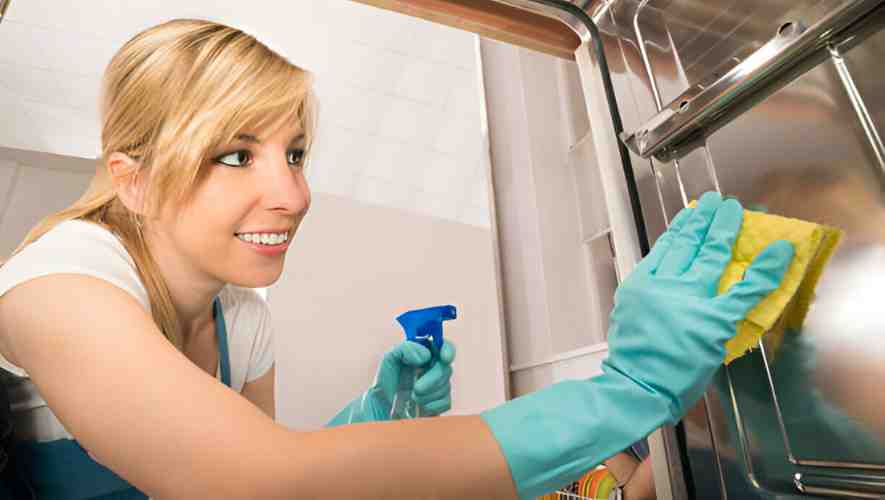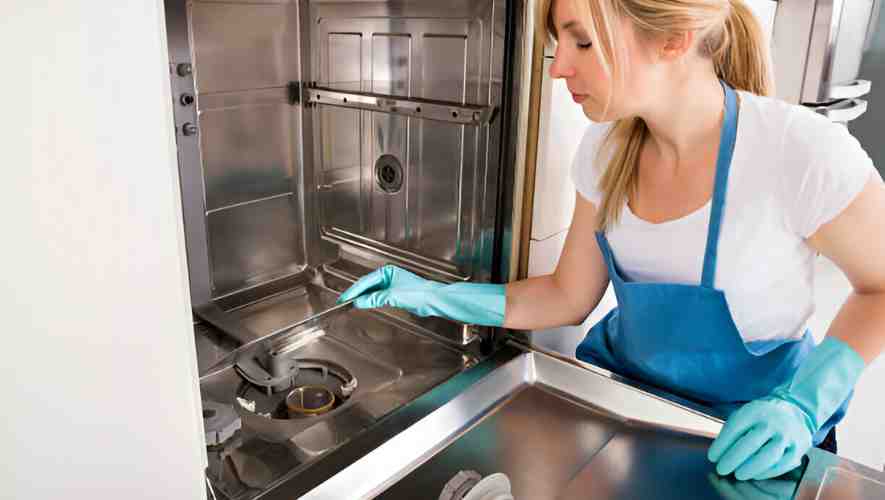
Ever noticed a puddle of suds around your dishwasher? A dishwasher leaking soap can be a real headache. This trusty appliance is supposed to make life easier, but when it starts to leak, things can get messy fast. If your dishwasher is leaking, it’s usually due to one of several common issues.
Why is My Dishwasher Leaking Soap? A leaky dishwasher often happens from using too much dish soap or the wrong detergent, causing suds and leaks.
First off, using too much dish soap or the wrong detergent can cause suds to overflow. A clog in the drain or a faulty hose might also be the culprit. During the wash cycle, if the spray arms are blocked or the rinse cycle isn’t working right, your washer might leak.
To avoid a dishwasher leaking all over your kitchen, regular cleaning and maintenance are key. Check for clogs, ensure the detergent is the right kind, and make sure the hose and spray arms are in good shape. A few simple tips and checks can save you from needing a costly repair. Keep your dishwasher clean and in top working order, and it’ll keep your kitchen running smoothly.
6 Common Reasons Why Your Dishwasher is Leaking Soap and Suds

1. Using the Wrong Dishwasher Detergent:
Using dishwasher detergent meant for hand washing can create excess suds and cause water to leak from the bottom of the dishwasher. Always make sure you’re using the right type of detergent specifically designed for dishwashers.
2. Overfilling the Dishwasher:
Loading too many dishes or using too much detergent can lead to excess soap foam. This foam can overflow and cause the dishwasher to leak. Be mindful of how much detergent you use and don’t overload your dishwasher.
3. Worn or Damaged Door Gasket:
The door gasket, or seal, around the dishwasher door, is crucial for keeping water and suds inside. If it’s worn out or damaged, it can cause leaks. Regularly inspect the door gasket and replace it if you notice any wear and tear.
4. Clogged or Faulty Float Switch:
The float switch helps regulate the water level inside the dishwasher tub. If it’s clogged or not working properly, it can cause the dishwasher to overfill and leak. Cleaning and maintaining the float switch can prevent this issue.
5. Faulty Inlet Valve:
The inlet valve controls the water flow into the dishwasher. If it’s broken or not functioning correctly, it can cause an overflow, leading to leaks. Regular maintenance and inspections can help identify and fix this problem early.
6. Cracks in the Dishwasher Tub:
Over time, the dishwasher tub can develop cracks, especially if it’s an older model. Cracks can cause water and suds to leak out during the wash cycle. If you notice water pooling at the bottom of the dishwasher, check for cracks in the tub and repair or replace it if necessary.
Tips for Preventing Leaks and Excess Suds
Regular Maintenance:
Perform regular maintenance on your dishwasher, including checking the door gasket, float switch, and inlet valve.
Use the Right Detergent:
Always use dishwasher detergent designed for your appliance to prevent excess foam and soap bubbles.
Avoid Overloading:
Don’t overload your dishwasher or use too much detergent. Both can lead to excess suds and leaks.
Inspect for Cracks:
Regularly inspect the dishwasher tub for cracks or damage that could cause leaks.
How to Fix a Dishwasher Leaking Due to Excessive Detergent or Overflow

1. Identify the Source of the Leak:
Before diving into repairing a dishwasher, you need to figure out where the leak is coming from. It could be from underneath the dishwasher, the door, or the drain line. Start by inspecting the area around and underneath the dishwasher to pinpoint the source of the leak.
2. Check for Excessive Suds:
Using the wrong type of detergent, like regular dish soap, can create excessive suds that overflow and cause leaks. If you see a lot of soap foam, it’s a clear sign that this might be the issue. To fix this, stop using regular dish soap and switch to the right dishwasher detergent.
3. Cancel and Drain the Cycle:
If you discover excessive suds, cancel the wash cycle immediately. Let the dishwasher drain to remove the excess water and suds. This step helps clear out the suds and prevents further overflow.
4. Clean the Inside of the Dishwasher:
After canceling the cycle, open the dishwasher and let it air out. Soak up any remaining suds and clean water with a towel. Check and clean the filter to remove any leftover soap residue that might be causing the suds to build up.
5. Inspect and Clean the Drain Line :
A clogged or partially blocked drain line can cause the dishwasher to overflow. Inspect the drain line connected to your sink and ensure it’s not clogged. Clear any blockages to help the dishwasher drain properly.
6. Use Rinse Aid Correctly:
Rinse aid can help reduce suds and improve drying performance. Make sure you’re using it correctly. Check the rinse aid dispenser and fill it if necessary. Follow the manufacturer’s instructions for the right amount.
7. Run a Rinse Cycle:
After cleaning and inspecting, run a rinse cycle with no detergent to flush out any remaining soap residue. This helps ensure that no leftover soaps are causing suds to overflow.
8. Inspect the Dishwasher Door and Gasket:
A faulty door gasket can also cause leaks. Inspect the door gasket for any signs of wear or damage. If the gasket is cracked or worn out, replace it to create a proper seal and prevent leaks.
9. Regular Maintenance and Inspection:
Regular maintenance is crucial to prevent leaks. Inspect your dishwasher regularly for any signs of wear and tear, especially around the door gasket, filter, and drain line. Regularly clean these parts to keep your dishwasher in good working condition.
10. Avoid Using Excessive Detergent:
One of the common reasons for a leaky dishwasher is using too much detergent. Always measure the detergent according to the manufacturer’s instructions. Excess detergent can cause excessive suds, leading to overflows and leaks.
11. Investigate for Cracks and Damage:
If you’ve tried all the above steps and your dishwasher is still leaking, inspect the dishwasher thoroughly for any cracks or damage. Sometimes, cracks in the dishwasher tub or other parts can cause leaks. If you find any, repair or replace the damaged parts.
Tips to Clean and Inspect Your Dishwasher Tub, Drain Hose, and Door Gasket

Keeping your dishwasher in tip-top shape is crucial for avoiding issues like leaks and ensuring it runs efficiently. Here are some tips to help you clean and inspect your dishwasher tub, drain hose, and door gasket.
1. Clean the Dishwasher Tub
Remove Debris:
Start by removing any visible debris from the bottom of the dishwasher tub. Food particles and other residues can build up over time, causing bad smells and clogs.
Run a Cleaning Cycle:
Using the right cleaner, run a cycle with no dishes to clean the inside of the dishwasher. You can use a dishwasher cleaning packet or even white vinegar. Just place the cleaner in the detergent dispenser or at the bottom of the tub and run a hot wash cycle.
Wipe Down the Interior:
After the cycle, wipe down the walls, door, and bottom of the tub with a damp cloth. This helps remove any leftover grime and soap scum.
2. Inspect and Clean the Drain Hose
Check for Clogs:
A clogged drain hose can cause water to back up and create a puddle inside your dishwasher. Disconnect the hose and inspect it for any blockages. Use a long brush or a thin, flexible tool to clear any clogs.
Rinse the Hose:
After clearing any blockages, rinse the hose with clean water to remove any remaining debris. Reconnect the hose securely to ensure there are no leaks.
Inspect for Damage:
While the hose is disconnected, check for any signs of wear or damage. If you see cracks or other issues, it’s best to replace the hose to prevent leaks.
3. Clean and Inspect the Door Gasket
Remove Food Particles:
The rubber gasket around the dishwasher door can also cause problems if it gets dirty. Clean the gasket with a damp cloth, removing any food particles or grime that may have accumulated.
Check for Damage:
Inspect the gasket for any signs of wear, such as cracks or tears. A damaged gasket can lead to leaks, so it’s important to replace it if you find any issues.
Ensure Proper Seal:
Make sure the gasket is properly seated in the groove around the door. A loose or misaligned gasket can also cause leaks.
4. Additional Tips for Maintenance
Use the Right Detergent:
Always use the right type of detergent designed for automatic dishwashers. Using the wrong detergent can lead to excessive suds, which can cause leaks and other issues.
Regular Maintenance:
Perform regular maintenance checks on your dishwasher, including the drain pump, to ensure everything is working correctly. Regularly running a cycle with a cleaner helps maintain the interior and keep it free of build-up.
Avoid Overloading:
Don’t overload your dishwasher. Overloading can prevent proper cleaning and also cause damage to the dishwasher’s components, leading to potential leaks.
Conclusion
Taking the time to clean and inspect your dishwasher tub, drain hose, and door gasket can save you from a lot of headaches down the road. Regular maintenance ensures your dishwasher runs smoothly, prevents leaks, and extends its lifespan. I’ve found that using the right detergent and not overloading the machine makes a big difference in keeping my dishwasher in top shape.
By following these tips, you can avoid the common issues that many face with their dishwashers. It’s a small effort that pays off in the long run, keeping your kitchen running efficiently and your dishwasher working like new. So next time you run a cycle, take a moment to check these key areas—you’ll be glad you did!
